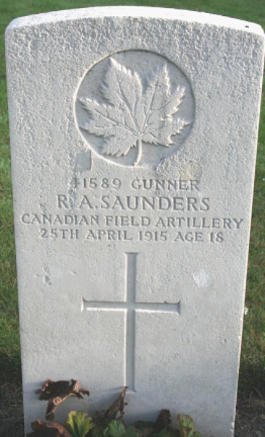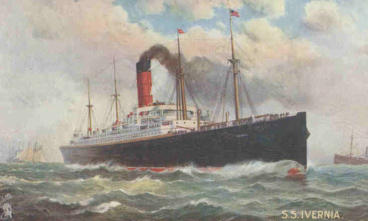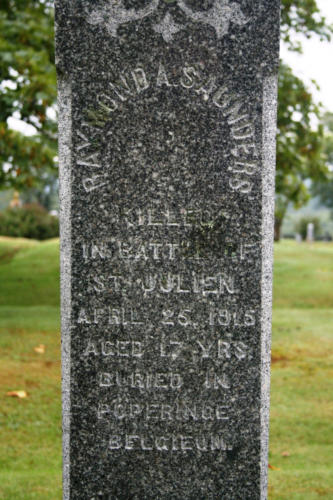
copyright © Wartime Heritage Association
Website hosting courtesy of Register.com - a web.com company
Wartime Heritage
ASSOCIATION
Remembering World War I
Yarmouth Connections

Raymond Arthur Saunders
Gunner
41589
Canadian Artillery
2nd Brigade, Canadian Field Artillery
6th Battery
April 10, 1896 (on Attestation Form)
April 10, 1898 (actual Date of Birth)
Hebron, Yarmouth Co., Nova Scotia
September 24, 1914
Valcartier, Quebec
Hebron, Yarmouth Co., Nova Scotia
18 (On Attestation) Actual age 16
5 Feet, 8 Inches
Dark
Hazel
Brown
Painter
Single
Baptist
Josiah C. Saunders (Father) Hebron, Yarmouth Co., NS
April 25, 1915
17
Killed in action Battle of St Julian
Poperinghe Old Military Cemetery, Belgium
II. J. 12.
Commemorated on Page 35 of the First World War Book of Remembrance
This page is displayed in the Memorial Chamber of the Peace Tower in Ottawa on January 30
Raymond Saunders was the son of Josiah Cann Saunders (1862-1936) and Bertha L. (Raymond)
Saunders (1865-1900).
At the outbreak of war, Raymond departed Yarmouth for Valcartier, Quebec to enlist. His medical
was completed on September 3, 1914 and officially signed his Attestation on September 24, 1914. He
departed Quebec for the United Kingdom on
October 3, 1914 sailing on the SS Ivernia.
On February 11, 1915 he embarked
Avonmouth, UK for France where he served
as a Gunner/Driver of an artillery piece
drawn by four horses.
During the Battle of St. Julian he was
severely wounded on April 24 and died from
wounds on April 25, 1915. The details of his
death are given in the letter written to his father.
After his death, Corporal Colin Gernon Palmer Campbell of Weymouth (later Lieutenant Campbell)
wrote to Raymond’s father.
Poperinghe Old Military Cemetery is located in the town of Poperinge, Belgium. There is a large
empty space at the front of the cemetery, apart from one grave, that of Gunner R A Saunders of the
Canadian Field Artillery who is buried next to the Cross of Sacrifice. Behind this are the graves which
make up Plot 2.
The town of Poperinghe
(now Poperinge) was of great
importance during the First
World War because, although
occasionally bombed or
bombarded at long range, it
was the nearest place to
Ypres which was both
considerable in size and
reasonably safe. It was at
first a centre for Casualty
Clearing Stations, but by
1916 it became necessary to
move these units further
back and field ambulances
took their places.
The earliest Commonwealth graves in the town are in the communal cemetery, which was used
from October 1914 to March 1915. The Old Military Cemetery was made in the course of the First
Battle of Ypres and was closed, so far as Commonwealth burials are concerned, at the beginning of May
1915. The New Military Cemetery was established in June 1915.
The Old Military Cemetery contains 450 Commonwealth burials and commemorations of the First
World War. 24 of the burials are unidentified but there are special memorials to seven casualties known
or believed to be buried among them.
Raymond Arthur Saunders




“... Ray was my best and only chum ... and I loved him more than life itself. It is
awful hard to lose someone one loves and I sympathize with you from the bottom of my
heart. Ray was a loving littler chap and was beloved by all the battery. All were his
friends and not a day passed but what he and I had some eventful time to mark our trip.
He had few troubles, if any, and was one of the finest chaps to work and look after his
team of horses which he took great pride in having better than anyone else’s. You should
be a proud man to have had such a son. He loved his relatives and home very much as he
has told me many a time of you all and of home.
We had just selected a place to make down our bed, and, as usual, he waited for
me to get the blankets and make our bed. This was to be just beside his horses and
behind a grove of small trees. There was quite a number of our fellows there and
several got wounded. I had just turned from him when the awful crash of a shell came.
Ray was lying down where his bed was to be and a piece of shell struck him on the left
side of the head cutting through his cap and seriously injuring him. He died twenty hours
later in hospital.
He had a shroud and coffin and was buried in the cemetery of that town. Although
we had quite a time to get a cross to mark his resting place we found a wheeler’s shop
and I made a nice one myself on which I painted his name, date of birth and birthplace.
With me was Gunner O.B. McNeil, of Hebron, NS and Gunner Charles Emin of Yarmouth.
We had prayers over his resting place and made arrangements to have it put in as nice
shape as possible.
I thought I would tell you this so you might rest easier. It was the will of God that
he had to leave all he loved and who loved him in this world to meet him in the next.
One great consolation is that he is now with his mother.”
C. G. Campbell, Corporal
(Source: A Monument Speaks; Arthur Thurston)
Name:
Rank:
Service No:
Service:
Date of Birth:
Place of Birth:
Date of Enlistment:
Place of Enlistment:
Address At Enlistment:
Age at Enlistment:
Height:
Complexion:
Eyes:
Hair:
Trade:
Marital Status:
Religion:
Next of Kin:
Date of Death:
Age at Death:
Cemetery:
Grave Reference:


Memorial
Located in the Riverside Cemetery, Hebron,
Yarmouth Co., Nova Scotia
Raymond A. Saunders
Killed in Battle of St. Julian
April 25, 1915
Aged 17 Yrs.
Buried in
Poperinge
Belgium


- World War I - Menu
- WWI Stories and Articles
- Photos - Yarmouth Soldiers
- Selection of World War I Songs
- WWI Casualties of Yarmouth, NS
- Those Who Served - Yarmouth, NS
- WWI Casualties Digby Co. NS
- WWI Casualties Shelburne Co. NS
- Merchant Mariners (1915) Yarmouth, NS
- Canadian Forestry Corps - Non Yarmouth Birth/Residence Enlistments
- US Draft Registry - Yarmouth NS Born


- World War II - Menu
- WWII Stories and Articles
- Telegraphist Air Gunners
- WWII Casualties of Nova Scotia
- US Casualties with NS Connection
- Far East/Pacific Casualties with NS Connection
- Merchant Navy Casualties Nova Scotia
- Nova Scotia WWII Casualties Holten Canadian War Cemetery
- D-Day Casualties - Nova Scotia
- CANLOAN Program Casualties - Nova Scotia
- Battle of the Bulge Casualties - Nova Scotia
- WWII Casualties Yarmouth NS
- Yarmouth Casualties - RCAF RAF Canadian Army WWII
- Yarmouth Co., Marriages WWII
- Casualties Non-Born/Residents with Connection to Yarmouth Co., Nova Scotia.
- WWII Casualties Digby Co., NS
- Non-Nova Scotian WWII Casualties Buried in Nova Scotia
- WWII RCAF Casualties Aged 16-18
- Brothers/Sisters Who Served - World War II













